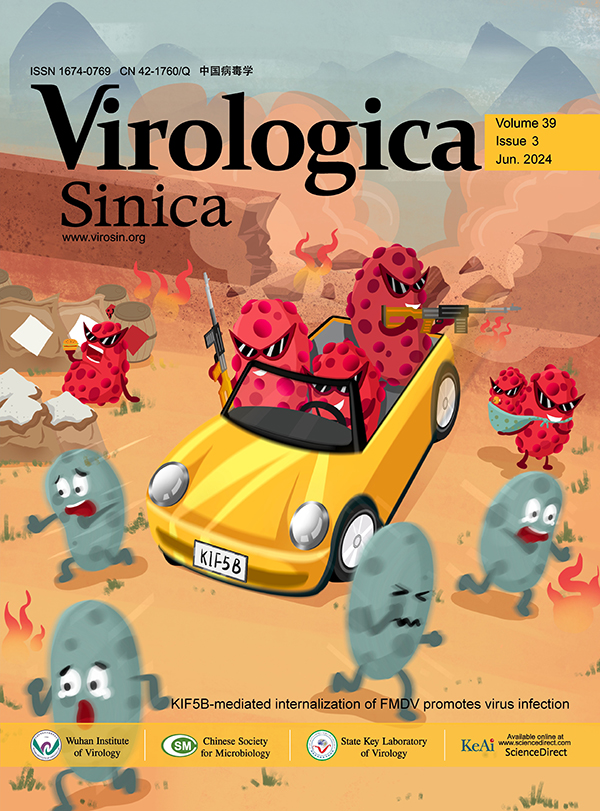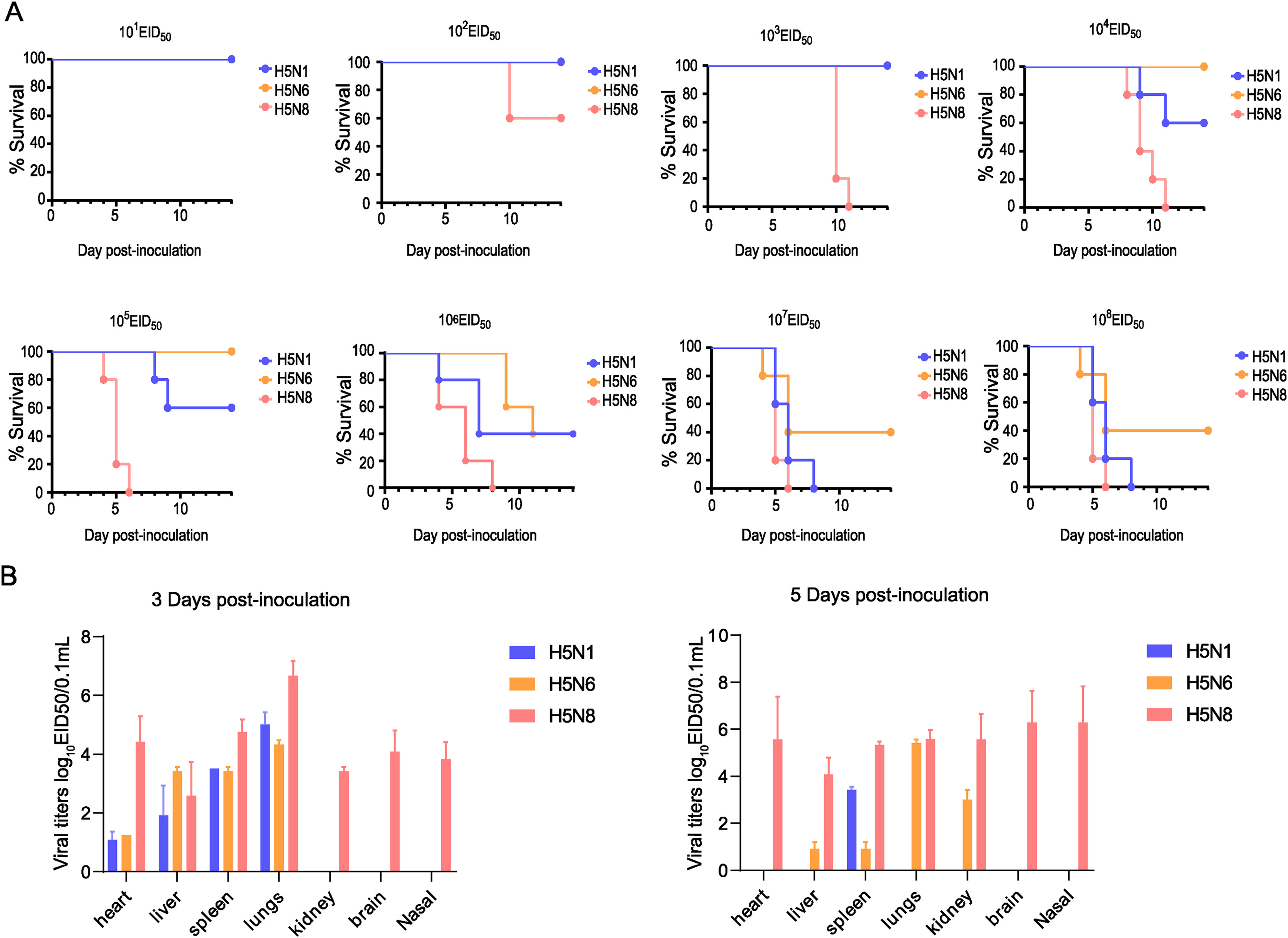-
Bhat, S., Bhatia, S., Pillai, A.S., Sood, R., Singh, V.K., Shrivas, O.P., Mishra, S.K., Mawale, N., 2015. Genetic and antigenic characterization of H5N1 viruses of clade 2.3.2.1 isolated in India. Microb Pathog 88, 87-93.
-
Bi, F., Jiang, L., Huang, L., Wei, J., Pan, X., Ju, Y., Mo, J., Chen, M., Kang, N., Tan, Y., Li, Y., Wang, J., 2021. Genetic Characterization of Two Human Cases Infected with the Avian Influenza A (H5N6) Viruses-Guangxi Zhuang Autonomous Region, China, 2021. China CDC Wkly 3, 923-928.
-
Bi, Y., Chen, J., Zhang, Z., Li, M., Cai, T., Sharshov, K., Susloparov, I., Shestopalov, A., Wong, G., He, Y., Xing, Z., Sun, J., Liu, D., Liu, Y., Liu, L., Liu, W., Lei, F., Shi, W., Gao, G.F., 2016a. Highly pathogenic avian influenza H5N1 Clade 2.3.2.1c virus in migratory birds, 2014-2015. Virol Sin 31, 300-305.
-
Bi, Y., Chen, Q., Wang, Q., Chen, J., Jin, T., Wong, G., Quan, C., Liu, J., Wu, J., Yin, R., Zhao, L., Li, M., Ding, Z., Zou, R., Xu, W., Li, H., Wang, H., Tian, K., Fu, G., Huang, Y., Shestopalov, A., Li, S., Xu, B., Yu, H., Luo, T., Lu, L., Xu, X., Luo, Y., Liu, Y., Shi, W., Liu, D., Gao, G.F., 2016b. Genesis, Evolution and Prevalence of H5N6 Avian Influenza Viruses in China. Cell Host Microbe 20, 810-821.
-
Bui, C.H.T., Kuok, D.I.T., Yeung, H.W., Ng, K.C., Chu, D.K.W., Webby, R.J., Nicholls, J.M., Peiris, J.S.M., Hui, K.P.Y., Chan, M.C.W., 2021. Risk assessment for highly pathogenic avian influenza a(H5N6/H5N8) Clade 2.3.4.4 Viruses. Emerg Infect Dis 27, 2619-2627.
-
Caliendo, V., Lewis, N.S., Pohlmann, A., Baillie, S.R., Banyard, A.C., Beer, M., Brown, I.H., Fouchier, R.A.M., Hansen, R.D.E., Lameris, T.K., Lang, A.S., Laurendeau, S., Lung, O., Robertson, G., van der Jeugd, H., Alkie, T.N., Thorup, K., van Toor, M.L., Waldenstrom, J., Yason, C., Kuiken, T., Berhane, Y., 2022. Transatlantic spread of highly pathogenic avian influenza H5N1 by wild birds from Europe to North America in 2021. Sci Rep 12, 11729.
-
Chen, J., Li, X., Xu, L., Xie, S., Jia, W., 2021. Health threats from increased antigenicity changes in H5N6-dominant subtypes, 2020 China. J Infect 83, e9-e11.
-
Chen, J., Xu, L., Liu, T., Xie, S., Li, K., Li, X., Zhang, M., Wu, Y., Wang, X., Wang, J., Shi, K., Niu, B., Liao, M., Jia, W., 2022. Novel Reassortant Avian Influenza A(H5N6) Virus, China, 2021. Emerg Infect Dis 28, 1701-1707.
-
Cui, P., Shi, J., Wang, C., Zhang, Y., Xing, X., Kong, H., Yan, C., Zeng, X., Liu, L., Tian, G., Li, C., Deng, G., Chen, H., 2022. Global dissemination of H5N1 influenza viruses bearing the clade 2.3.4.4b HA gene and biologic analysis of the ones detected in China. Emerg Microbes Infect 11, 1693-1704.
-
Gu, W., Shi, J., Cui, P., Yan, C., Zhang, Yaping, Wang, C., Zhang, Yuancheng, Xing, X., Zeng, X., Liu, L., Tian, G., Suzuki, Y., Li, C., Deng, G., Chen, H., 2022. Novel H5N6 reassortants bearing the clade 2.3.4.4b HA gene of H5N8 virus have been detected in poultry and caused multiple human infections in China. Emerg Microbes Infect 11, 1174-1185.
-
Gunther, A., Krone, O., Svansson, V., Pohlmann, A., King, J., Hallgrimsson, G.T., Skarphedhinsson, K.H., Sigurdhardottir, H., Jonsson, S.R., Beer, M., Brugger, B., Harder, T., 2022. Iceland as Stepping Stone for Spread of Highly Pathogenic Avian Influenza Virus between Europe and North America. Emerg Infect Dis 28, 2383-2388.
-
Hill, V., Baele, G., 2019. Bayesian Estimation of Past Population Dynamics in BEAST 1.10 Using the Skygrid Coalescent Model. Mol Biol Evol 36, 2620-2628.
-
Huang, J., Wu, S., Wu, W., Liang, Y., Zhuang, H., Ye, Z., Qu, X., Liao, M., Jiao, P., 2021. The Biological Characteristics of Novel H5N6 Highly Pathogenic Avian Influenza Virus and Its Pathogenesis in Ducks. Front Microbiol 12, 628545.
-
Isoda, N., Onuma, M., Hiono, T., Sobolev, I., Lim, H.Y., Nabeshima, K., Honjyo, H., Yokoyama, M., Shestopalov, A., Sakoda, Y., 2022. Detection of New H5N1 High Pathogenicity Avian Influenza Viruses in Winter 2021-2022 in the Far East, Which Are Genetically Close to Those in Europe. Viruses 14, 2168.
-
Jiang W, Dong C, Liu S, Peng C, Yin X, Liang S, Zhang L, Li J, Yu X, Li Y, Wang J, Hou G, Zeng Z, Liu H, 2022. Emerging Novel Reassortant Influenza A(H5N6) Viruses in Poultry and Humans, China, 2021. Emerg Infect Dis 28, 1064-1066.
-
Kalyaanamoorthy, S., Minh, B.Q., Wong, T.K.F., Von Haeseler, A., Jermiin, L.S., 2017. ModelFinder: Fast model selection for accurate phylogenetic estimates. Nat Methods 14, 587-589.
-
Ke, X., Yao, Z., Tang, Y., Yang, M., Li, Y., Yang, G., Chen, J., Chen, G., Feng, W., Zheng, H., Chen, Q., 2022. Highly Pathogenic Avian Influenza A (H5N1) Virus in Swans, Central China, 2021. Microbiol Spectr 10.
-
Kuiken, T., Cromie, R., 2022. Protect wildlife from livestock diseases. Science 738, 5.
-
Lo, Fatou T., Zecchin, B., Diallo, A.A., Racky, O., Tassoni, L., Diop Aida, Diouf, Moussa, Diouf, Mayekor, Samb, Y.N., Ambra, P., Federica, G., Ellero, F., Diop, M., Lo, M.M., Diouf, M.N., Fall, M., Ndiaye, A.A., Ndumu, D.B., Gaye, A.M., Badiane, M., Lo, M., Youm, B.N., Ndao, I., Niaga, M., Terregino, C., Diop, B., Ndiaye, Y., Angot, A., Seck, I., Niang, M., Soumare, B., Fusaro, A., Monne, I., 2022. Intercontinental Spread of Eurasian Highly Pathogenic Avian Influenza A(H5N1) to Senegal. Emerg Infect Dis 28, 234-237.
-
Peng, Y., Zou, Y., Li, H., Li, K., Jiang, T., 2014. Inferring the antigenic epitopes for highly pathogenic avian influenza H5N1 viruses. Vaccine 32, 671-676.
-
PIZZI, M., 1950. Sampling variation of the fifty percent end-point, determined by the Reed-Muench (Behrens) method. Hum Biol 22, 150-190.
-
Pyankova, O.G., Susloparov, I.M., Moiseeva, A.A., Kolosova, N.P., Onkhonova, G.S., Danilenko, A. V., Vakalova, E. V., Shendo, G.L., Nekeshina, N.N., Noskova, L.N., Demina, J. V., Frolova, N. V., Gavrilova, E. V., Maksyutov, R.A., Ryzhikov, A.B., 2021. Isolation of clade 2.3.4.4b A(H5N8), a highly pathogenic avian influenza virus, from a worker during an outbreak on a poultry farm, Russia, December 2020. Euro Surveill 26, 2100439.
-
Rambaut, A., Lam, T.T., Carvalho, L.M., Pybus, O.G., 2016. Exploring the temporal structure of heterochronous sequences using TempEst (formerly Path-O-Gen). Virus Evol 2, vew007.
-
Samir, M., Hamed, M., Abdallah, F., Kinh Nguyen, V., Hernandez-Vargas, E.A., Seehusen, F., Baumgartner, W., Hussein, A., Ali, A.A.H., Pessler, F., 2018. An Egyptian HPAI H5N1 isolate from clade 2.2.1.2 is highly pathogenic in an experimentally infected domestic duck breed (Sudani duck). Transbound Emerg Dis 65, 859-873.
-
Sanogo, I.N., Djegui, F., Akpo, Y., Gnanvi, C., Dupre, G., Rubrum, A., Jeevan, T., McKenzie, P., Webby, R.J., Ducatez, M.F., 2022. Highly Pathogenic Avian Influenza A(H5N1) Clade 2.3.4.4b Virus in Poultry, Benin, 2021. Emerg Infect Dis 28, 2534-2537.
-
Shi, J., Deng, G., Kong, H., Gu, C., Ma, S., Yin, X., Zeng, X., Cui, P., Chen, Y., Yang, H., Wan, X., Wang, X., Liu, L., Chen, P., Jiang, Y., Liu, J., Guan, Y., Suzuki, Y., Li, M., Qu, Z., Guan, L., Zang, J., Gu, W., Han, S., Song, Y., Hu, Y., Wang, Z., Gu, L., Yang, W., Liang, L., Bao, H., Tian, G., Li, Y., Qiao, C., Jiang, L., Li, C., Bu, Z., Chen, H., 2017. H7N9 virulent mutants detected in chickens in China pose an increased threat to humans. Cell Res 27, 1409-1421.
-
Shi, J., Deng, G., Ma, S., Zeng, X., Yin, X., Li, M., Zhang, B., Cui, P., Chen, Y., Yang, H., Wan, X., Liu, L., Chen, P., Jiang, Y., Guan, Y., Liu, J., Gu, W., Han, S., Song, Y., Liang, L., Qu, Z., Hou, Y., Wang, X., Bao, H., Tian, G., Li, Y., Jiang, L., Li, C., Chen, H., 2018. Rapid Evolution of H7N9 Highly Pathogenic Viruses that Emerged in China in 2017. Cell Host Microbe 24, 558-568.e7.
-
Shi, J., Zeng, X., Cui, P., Yan, C., Chen, H., 2023. Alarming situation of emerging H5 and H7 avian influenza and effective control strategies. Emerg Microbes Infect 12, 2155072.
-
Shi, W., Gao, G.F., 2021. Emerging H5N8 avian influenza viruses: The global spread of H5N8 avian influenza viruses is a public health concern. Science 372, 784-786.
-
Smith, D.J., Lapedes, A.S., de Jong, J.C., Bestobroer, T.M., Rimmelzwaan, G.F., Osterhaus, A.D.M.E., Fouchier, R.A.M., 2004. Mapping the antigenic and genetic evolution of influenza virus. Science 305, 371-374.
-
Stokstad, E., 2022. Deadly bird flu establishes a foothold in North America. Science 377, 912.
-
Swieton, E., Fusaro, A., Fusaro, A., Shittu, I., Niemczuk, K., Zecchin, B., Joannis, T., Bonfante, F., Mietanka, K., Terregino, C., 2020. Sub-Saharan Africa and Eurasia Ancestry of Reassortant Highly Pathogenic Avian Influenza A(H5N8) Virus, Europe, December 2019. Emerg Infect Dis 26, 1557-1561.
-
Verhagen, J.H., Fouchier, R.A.M., Lewis, N., 2021. Highly Pathogenic Avian Influenza Viruses at the Wild-Domestic Bird Interface in Europe: Future Directions for Research and Surveillance. Viruses 13, 212.
-
Weaver, S., Shank, S.D., Spielman, S.J., Li, M., Muse, S. V., Kosakovsky Pond, S.L., 2018. Datamonkey 2.0: A modern web application for characterizing selective and other evolutionary processes. Mol Biol Evol 35, 773-777.
-
Wiley, D.C., Wilson, I.A., Skehel, J.J., 1981. Structural identifcation of the antibody-binding sites of Hong Kong influenza haemagglutinin and their involvement in antigenic variation, 25. Lazarowitz, S. G. & Choppin, P. W. Virology 289, 2737-2740.
-
Wille, M., Barr, I.G., 2022. Resurgence of avian influenza virus. Science 376, 459-460.
-
Xiao, C., Xu, J., Lan, Y., Huang, Z., Zhou, L., Guo, Y., Li, X., Yang, L., Gao, G. F., Wang, D., Liu, W. J., Zhou, X., Yang, H., 2021. Five Independent Cases of Human Infection with Avian Influenza H5N6-Sichuan Province, China, 2021. China CDC Wkly 3, 751-756.
-
Yamashita, A., Kawashita, N., Kubota-Koketsu, R., Inoue, Y., Watanabe, Y., Ibrahim, M.S., Ideno, S., Yunoki, M., Okuno, Y., Takagi, T., Yasunaga, T., Ikuta, K., 2010. Highly conserved sequences for human neutralization epitope on hemagglutinin of influenza A viruses H3N2, H1N1 and H5N1: Implication for human monoclonal antibody recognition. Biochem Biophys Res Commun 393, 614-618.
-
Zhang, C., Wang, Z.Y., Cui, H., Chen, L.G., Zhang, C.M., Chen, Z.L., Dong, S.S., Zhao, K., Fu, Y.Y., Liu, J.X., Guo, Z.D., 2023. Emergence of H5N8 avian influenza virus in domestic geese in a wild bird habitat, Yishui Lake, north central China. Virol Sin 38, 157-161.
-
Zhang, G., Li, B., Raghwani, J., Vrancken, B., Jia, R., Hill, S.C., Fournie, G., Cheng, Y., Yang, Q., Wang, Y., Wang, Z., Dong, L., Pybus, O.G., Tian, H., 2023. Bidirectional Movement of Emerging H5N8 Avian Influenza Viruses between Europe and Asia via Migratory Birds since Early 2020. Mol Biol Evol 40, msad019.
-
Zhang, J., Li, X., Wang, X., Ye, H., Li, B., Chen, Y., Chen, J., Zhang, T., Qiu, Z., Li, H., Jia, W., Liao, M., Qi, W., 2021. Genomic evolution, transmission dynamics, and pathogenicity of avian influenza A (H5N8) viruses emerging in China, 2020. Virus Evol 7, veab046.
-
Zhang J, Ye H, Liu Y, Liao M, QI W, 2022. Resurgence of H5N6 avian influenza virus in 2021 poses new threat to public health. Lancet Microbe 3, e558.














 DownLoad:
DownLoad: